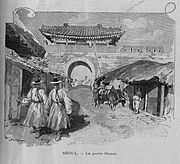37°34′05.68″N 126°58′08.31″E / 37.5682444°N 126.9689750°E / 37.5682444; 126.9689750
| Seodaemun | |
 Donuimun, as photographed in 1904 by Horace Grant Underwood "...Japanese troops entering the city of Seoul..." Donuimun, as photographed in 1904 by Horace Grant Underwood "...Japanese troops entering the city of Seoul..." | |
| Korean name | |
|---|---|
| Hangul | 돈의문 |
| Hanja | 敦義門 |
| Revised Romanization | Donuimun |
| McCune–Reischauer | Tonŭimun |
Donuimun (Korean: 돈의문; lit. Loyalty Gate), sometimes called the West Gate or Seodaemun (서대문; 西大門; lit. West Big Gate), was one of the Eight Gates of Seoul in Seoul, South Korea. The gate served as the westeren opening to the Fortress Wall that surrounded the city during the Joseon period.
It was originally built in 1396, destroyed during the 16th century, and then rebuilt in 1711. However, it was again destroyed in 1915, during the Japanese occupation of Korea, and has not since been rebuilt.
History
Donuimun was originally built in 1396. It was burned as a result of the 16th century invasions by Japan, but was rebuilt in 1711. In 1413, the gate was closed. In 1422, Donuimun gate was repaired. In 1711, Donuimun Gate was rebuilt in 1711. In 1915, the gate was again destroyed during the Japanese colonial period. The gate was photographed at various times before its destruction, most notably by in a series of photographs taken by Presbyterian missionary Horace Grant Underwood in 1904. Some of these photographs show the tracks of an "American Electric Tramway" running through the gate.
The name Donuimun means literally "Loyalty Gate." It was one of the Four Great Gates in the Fortress Wall of Seoul.
Preservation
Donuimun was demolished in 1915, during Japanese rule of Korea, in order to facilitate the construction of a tram line. In 2009, Seoul Metropolitan Government announced plans to rebuild Donuimun, using maps from the Joseon era to the present day, in addition to conducting surveys and excavations.
Officials originally envision the project to be complete by 2013, but was delayed to 2022, due to budget issues.
Currently, an art piece titled "Invisible Gate" stands over the Donuimun site.
Images
-
 Donuimun sketch, ca. 1894.
Donuimun sketch, ca. 1894.
-
 Painting by Constance J. D. Coulson (1910)
Painting by Constance J. D. Coulson (1910)
-
 Donuimun Memorial, May 2012.
Donuimun Memorial, May 2012.
-
 Donuimun Signboard, as represented on the current memorial.
Donuimun Signboard, as represented on the current memorial.
-
 Back of Donuimun Memorial, May 2012.
Back of Donuimun Memorial, May 2012.
-
 Signage from back of Donuimun Memorial, May 2012.
Signage from back of Donuimun Memorial, May 2012.
References
- "Seoul City to Restore Ancient West Gate". Chosun Ilbo.
- "travel2seoul". Archived from the original on 4 December 2014. Retrieved 1 December 2014.
- 이, 장희, "돈의문 (敦義門) Donuimun", 한국민족문화대백과사전 (in Korean), Academy of Korean Studies, retrieved 2024-10-30
- "The Gates and Walls of Seoul". Korean News Today. Archived from the original on 2012-12-08.
- ^ "Seoul City to Restore Ancient West Gate". The Chosun Ilbo. 22 October 2009. Retrieved 24 February 2018.
- 日帝가 허문 '돈의문' 복원 불투명 (in Korean). Munhwa Ilbo. 2012-12-10. Retrieved 2013-04-30.
- Seoul City Wall Guide Book. Seoul Metropolitan Government. 11 December 2014. p. 42. ISBN 9791156211907. Retrieved 24 February 2018.
| The Eight Gates of Seoul | |
|---|---|
| The Four Great Gates |
|
| The Four Small Gates |
|
| Related | |